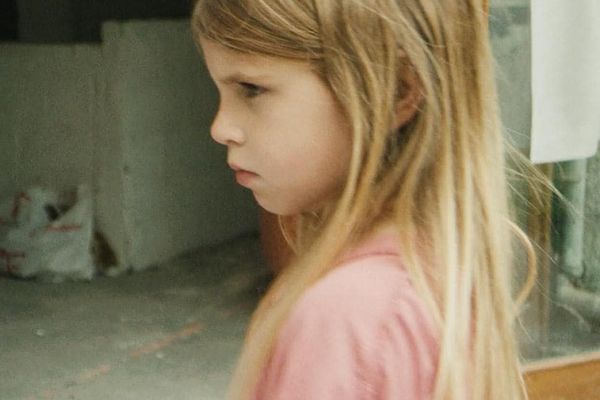Eye For Film >> Movies >> Nocomodo (2022) Film Review
Nocomodo
Reviewed by: Andrew Robertson

Straight in with the percussion, the rasp of file and sandpaper against plaster. Something wrapped in plastic bubbles, the radio off to the rush of water from tap, the illiquid slide of soap from sink.
On the way to the movie theatre the sound of the city is deafening, a clamour of car and carriageway. In the screen a moment. Surrounded by art, sculpture, paintings, hummed melodies, cinema. In the middle of it a child, Selma, "Dodo". On that trip the colleague of her father touches her. We don't see more than that. It makes it no less distressing.
The sound of water, refractive through the car window, the mask, memory. "aco-mo-date" [sic]. "deal with it". Distorted and strident, elided and evaded. Who takes credit? Who suffers the consequences? Who wears which masks?
Lola Halifa-Legrande's film is not an easy watch. Tissem Boukchem's performance is striking in part because of how it is framed. There are any number of considerations for working with child actors and given the subject matter those concerns are even weightier.
The original music of two songs, Elios, Martha, the opening melody Aoi Kitsune and Clara Doufourmantelle's Mama build towards an artistic grounding. Sarah Knill Jones provided the paintings for Dodo's mother, the fact that the film she is taken to is Philipe Grandrieux' 1998 serial killer thriller Sombre is another upsetting detail in a film full of them. Our focus is carefully directed, eyes, hands, paces and capes, repetition to babble and resolve to battle.
Screening as part of the shorts programme of the 90th anniversary (and 79th edition) of the Venice International Film Festival, Nocomodo sits in good company. Distressing and affirming, it is in its subtleties that it draws its strengths. Bound up in the arts there's certainly something in its analysis of perception, of the perceptual weaknesses of conceptual models. Where does the crocodile look?
The second film for Halifa-Legrand, Nocomodo shows a fiery talent. It is itself a challenge to the message within it, a cri de coeur of resistance. It sets out to unsettle, brimming with piss if not vinegar. Fanny Moyazer's camera is called upon to document all manner of visions and succeeds throughout. What it shows and does not show is a function of writing and direction, and Halifa-Legrand is not quite credited for either. "Un film de"... and all that hides within it.
In programme notes we are told Selma is seven or approaching it, but that is at once detail too far and detail too few. It is reflected but not stated in the film, and it's that space that gives Nocomodo both its strength and its fragility. At 13 minutes or so it is engineered for speed, even when it seems to dawdle it is building something in its pacing. Those faint feints are gaps into which other readings might creep, and for all that it punches above its weight there are places where it telegraphs what might have been surprise. It is uplifting, but that is after some distress, the softness of its touch belies its strength.
Reviewed on: 30 Sep 2022














